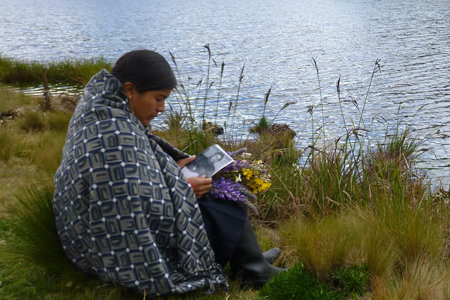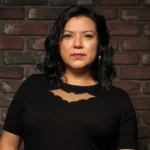Continuing with my Hot Docs coverage, I had the pleasure of speaking with Daughter Of The Lake director Ernesto Cabellos Damián, along with Nélida Ayay Chilón, the central subject of this film.
Following in the theme of Indigenous rights and their connection to the land, this film introduces us to Nélida, an Andean woman who feels she is a daughter of the lakes that provide water to her village. But just beneath these lakes, Yanacocha, Latin America’s largest gold mine, has discovered a deposit valued at billions of dollars. The company has Peruvian government’s support to mine there, even though it means drying out the lakes. Daughter Of The Lake takes us on a journey through Cajamarca, Perú; as well as, Bolivia and even Holland to point out how the industry prospers at high cost to these communities.
In our conversation, Ernesto described how the idea for this film had evolved from a more autobiographical tone, in which he would narrate the story, to the current version in which Nélida is the main focus. Ernesto explained he was aware of Nélida’s prior involvement locally to stand against the mining corporation, and speak for the lakes. As he and Nélida spoke about the film and its purpose, it became clearer that she was to be the narrator. “She gives a face to the story in this film”, he shared.
In her soft-spoken but determined tone, Nélida explained how in her community, “everything has life”. Her grandfather has always told her that “water is the blood of the land. Water is not only a natural resource, [it gives us life]. If we contaminate it, how can we drink it?” She emphasized that if there is no water, her community cannot survive. As well, she reminded me that the spirits of the lake would also disappear. Nélida is keenly aware that many will not understand her beliefs in Mother Water and Mother Earth. “We have different ways of seeing [the same world we live in]”, she said.

Ernesto pointed out how a Catholic majority in Perú also has a difficult time understanding the beliefs of Indigenous Andean people. This, mixed with governmental approval along with promises of economic development and employment opportunities, gives the mining companies more power over the land and resources. Yet who speaks for those directly affected? In this case, Nélida is more than qualified to do so. She is still finishing law school, but at times, she finds it difficult. She’s chosen this path in order to help her community and defend Mother Earth and Mother Water. But having an education is often not enough when dealing with local authorities. Indigenous people are often not given much credence by the authorities, in Nélida’s words, “they do not respect us as people and they do not respect our beliefs”. Yet she keeps on fighting.
The message in Daughter Of The Lake, and that of Nélida as well, is that natural resources are not infinite. Our world is plagued by consumerism, in which people want more and more, but the costs and long-term effects from extractive practices are quite high and perilous. Both Nélida and Ernesto have hopes this film will help us understand the situation affecting the local communities. But also, they hope it helps us see how we are all connected to this world and one another. Ernesto put it nicely in saying, “a film will not change the world but it can inspire small changes… If we can be better informed, then we can make changes in the world around us, which can then lead to bigger changes”.
This is certainly a profound issue brought forth by various films at Hot Docs this year. I encourage you to attend one of the two screenings left for Daughter Of The Lake. It is not only a timely film with a very engaging woman leading us through it; it is also a lovely visual journey that reminds us of the beauty in water and nature.
Hot Docs 2015 Screenings
Thu April 30, 6:15 PM
TIFF Bell Lightbox
Sat May 2, 4:30 PM
Scotiabank Theatre






